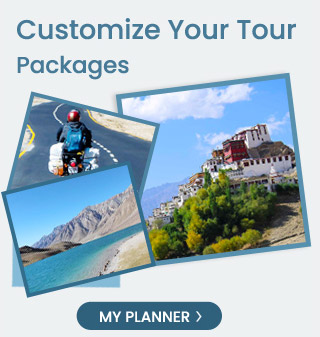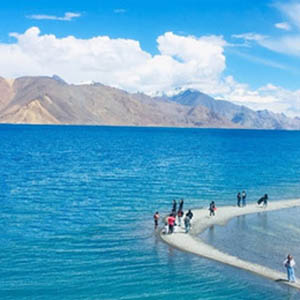Innerline Permits in Ladakh
![]()
Inner Line Permit or Restricted Area Permit/ Protected Area Permit is an official travel document that is issued and stamped by the Indian Authorities to allow the tourists to visit the protected areas of Ladakh. It is mandatory to obtain the permit for domestic as well international tourists visiting the protected areas of Ladakh.
There are two types of permits namely Inner Liner Permit (ILP) and Protected Area Permit or Restricted Area Permit (PAP/ RAP). These are required to visit those areas which are situated near the international borders such as in the proximity of Line of Control (border with Pakistan) and Line of Actual Control (border with China). Due to the security purpose, every tourist requires to obtain them. Here is the detailed information about the types of permits, how to obtain them, for which place they are required, and the cost of the permit.
What is Inner Line Permit (ILP)?
Inner Line Permit, or ILP, is a travel document issued by the government authorities, which allows Indian travelers to travel to a protected area for a limited time period. However, there is no limit on the number of times a tourist can visit these places within the valid period as long as they have required permits. The Inner Line Permit or ILP is valid for a period of 3 weeks for Indians. This can be applied by two modes – online and offline mode.
What is the process to obtain the Inner Line Permit online?
To obtain the permit online mode, one has to visit the official website of LAHDC (Leh Ladakh Autonomous Hill Development Council) http://lahdclehpermit.in/. The whole process for obtaining the permit has been described below.
- Firstly, visit the Leh Permit and then click on the half-circle which appears at the bottom of the screen and reads “Issue”. Then a fly menu will appear on the screen, click on “Domestic Clients”.
- Fill in your details elaborately.
- Next, mention the year of your travel, your name, the state you reside in, and your gender. Click on the ID type on the drop-down menu, which is available at that time.
- Fill out the information of Aadhar Card, Driving License, Passport, or Voter ID number.
- Mention the complete address
- Under the section, “Issue Permit” field, select “Directly”.
- Click on the field mentioned “Date of Arrival”. Select the date of arrival in Leh town.
- After completely filling all the information, review the entire form once again as after submitting the form there are no changes in the information are allowed.
- Next, click the “Submit” button. A fly-out will appear on the screen, which means the permit has been successfully registered. Click “Ok”.
- After that, select the areas that you need an Inner Line Permit for.
- At the bottom of the screen, select your date of arrival in Leh as well as the date of departure.
- Select the apply button for Permit
- A new fly-out will pop up on the screen informing you that the circuit has been assigned successfully. Click OK.
- A new pop-up that reads “Inserted Successfully” will appear on the screen. Click OK.
- After this, the next page will appear which will contain the details of your permit. The page will mention your name, ID number, state of residence, and different fee-related structures.
- Afterward, take a printout of the form and visit the DC Office, Leh to get the permit stamped in person.
What is the process to obtain Inner Line Permit Offline?
For offline mode, the traveler is required to directly visit the DC Office in Leh where they have to fill the form, pay the fees, and get the permit stamped. It is necessary to show valid photo identity proof issued by the government to get the permit stamped. Keep the extra copies of the Inner Line Permit while traveling as the copies are required to submit at several checkpoints.
Where should I make the payment?
If someone applies for the permit online, then they can pay the fees by both online and offline modes. In the case of online mode, it is required to carry the payment receipt along with the permits to the DC Office to get the permits signed and stamped. Otherwise, the payment can be done directly at the DC Office.
What is Protected Area Permit/ Restricted Area Permit (PAP/ RAP)?
The Restricted or Protected Area Permit (RAP/ PAP) is required for foreign nationals and it can be issued to a group of tourists consisting of two or more persons. If someone is planning to visit here alone then they have to contact the tour agent who will help them to add with any group. However, it is not mandatory for the tourist to travel in the same group or with the same travel agent mentioned in the permit. The tourists are allowed to visit specific tourist circuits with the exact entry and exit points. Foreigners are not allowed to visit areas other than the ones indicated in the permit. Also, they are not allowed to stay in the restricted/ protected area after the expiry of the permit.
What is the process to obtain the Protected Area Permit/ Restricted Area Permit?
The permit can be applied on the official website of the LAHDC (Leh Ladakh Autonomous Hill Development Council) http://lahdclehpermit.in/ or it can be applied through the registered travel agent in Leh. The RAP/ PAP can be procured for only a maximum of 7 days. The PAP/ RAP can be issued again after 7 days and tourists can visit the same place as many times as they want. For applying for the PAP/ RAP the photocopy of passport and photocopy of Indian visa required.
Which Areas Need an Inner Line Permit and Protected Area Permit/ Restricted Area Permit?
Please noted that the Inner line Permit and Protected Area Permit or Restricted Area Permit is not required for visiting all the areas. In fact, it is only required for some areas like Nubra valley, Khardung La, Pangong Tso, Tso Moriri, Dah and Hanu Villages, Man, Merak, Nyoma, Loma Bend, Turtuk, and Chushul.
No permit is required for local sightseeing around Leh, Zanskar Valley, Suru Valley. Restricted Area Permits or Protected Area Permits (RAP/ PAP) are now also issued for Chitkan, Dah, Garkone, Darchik, and Bata
Special cases
Visitors from Afghanistan, Bangladesh, China, Myanmar, Pakistan, and Sri Lanka will not be able to obtain a permit from the Deputy Commissioner’s Office in Leh. They will have to apply for an Inner Line Permit from the Ministry of Home Affairs in New Delhi.
Foreigners holding a diplomatic passport and members of the United Nations will have to apply for a permit from the Ministry of External Affairs in New Delhi.
- Passes
- Lakes
- Monasteries
- Attractions
- How to Prepare for Ladakh Trip
- Facilities in Ladakh
- Climate
- Family Trip to Ladakh
- How and Where to Carry Spare Fuel
- Ladakh With Parents - Senior Citizens
- How to Carry Laptop
- ATM and Bank Facilities in Leh City
- Things to Carry for Ladakh Winter Trip
- Where & How to Rent an Oxygen Cylinder
- Ladakh in June
- Ladakh in May
- Ladakh in July
- Ladakh in September
- Ladakh in October
- Ladakh in August
- Ladakh in November
- Leh to Nubra Valley
- Delhi to Ladakh
- Bangalore to Ladakh
- Pangong Lake to Tso Moriri
- Travel from Manali to Leh
- Leh to Tso Moriri
- How to Travel to Pangong Tso
- How to Travel Nubra Valley to Pangong Tso via Wari
- Srinagar to Leh
- Leh to Khardung La
- Stay in Ladakh
- Rent a Bike in Ladakh
- Rent a Bike in Leh
- Rent a Bike in Srinagar
- Rent a Bike in Manali
- Mobile Phone Services in Ladakh
- Hotels on Manali Leh Highway
- Hotels on Srinagar Leh Highway
- Hotels Near Tso Moriri
- Hotels in Leh
- Hotels Near Pangong Lake
- Hotels in Nubra Valley
- Mountain Biking
- Leh Jeep Safari
- Adventure Sports
- Mountaineering in Ladakh
- Camping in Ladakh
- Lifestyle
- Buddhism in Ladakh
- Cuisine in Ladakh
- River Rafting in Ladakh
- History & Culture
- Shopping in Ladakh
- Trekking in Ladakh
- Wildlife in Ladakh
- Tips and Suggestions
- Ladakh in January
- Ladakh in December
- Clothes to carry for your Ladakh Trip
- Medical Facilities
















